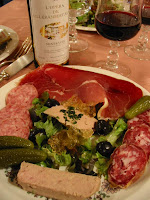Different categories of French wine are named after the region from where they are produced. Bordeaux wines, for example, are produced from grapes grown in the Bordeaux region near the Atlantic coast. Champagne is produced in the Champagne region. Did you know that a wine producer cannot call his product "champagne" if the grapes aren't grown in France's Champagne region? They have to call it "sparkling white wine," even if the same variety of grape is used, but in another country.
The Bordeaux region is divided into three subdivisions by the Gironde estuary and its tributaries, the Garonne and Dordogne rivers. The blend of grapes, oceanic climate, and soil (blend of gravel, sand stone and clay) are vital to the success of Bordeaux wines.
The most celebrated of Bordeaux chateaux is (arguably) Chateau Margaux. The grand cru of Chateau Margaux 1945 is considered by many as "the best wine of the century." A quick Internet search today found bottles for sale ranging from $2500 - $3800 USD per bottle (source). And the Chateau's website hails the 1900 vintage as one of the greatest wines they have ever tasted. I found one bottle online retailing for $10,000! (source).
 I lived for a short time in the Bourgogne Region of France, where wine we call Burgundy is produced. In Bourgogne, "immense attention is paid to the area of origin, and in which of the region's 400 types of soil a wine's grapes are grown. As opposed to Bordeaux, where classifications are producer-driven and awarded to individual chateaux, Burgundy classifications are geographically-focused. A specific vineyard or region will bear a given classification, regardless of the wine's producer. This focus is reflected on the wine's labels where appellations are most prominent and producer's names often appear at the bottom in much smaller text." (Source)
I lived for a short time in the Bourgogne Region of France, where wine we call Burgundy is produced. In Bourgogne, "immense attention is paid to the area of origin, and in which of the region's 400 types of soil a wine's grapes are grown. As opposed to Bordeaux, where classifications are producer-driven and awarded to individual chateaux, Burgundy classifications are geographically-focused. A specific vineyard or region will bear a given classification, regardless of the wine's producer. This focus is reflected on the wine's labels where appellations are most prominent and producer's names often appear at the bottom in much smaller text." (Source)The stones (galets, or "pebbles") surrounding the vines retain heat during the day and release it at night, which can have an effect of hastening the ripening of grapes. The stones can also serve as a protective layer to help retain moisture in the soil during the dry summer months. (Source)
Every November, France waits with impatience for the introduction of the year's Beaujolais Nouveau. Unlike most French wines that are aged for a number of years before they are sold, Beaujolais Nouveau is a purple-pink, lightweight wine intended for immediate consumption and should not be kept for longer than one year. The method of production yields very little tannin, (the astringency from tannin causes a dry and puckery feeling in the mouth following the consumption of red wine), allowing a somewhat fruity characteristic to dominate the taste. And, every vintage uses a different, new blend of grapes, so there is considerable hype surrounding the release of the new Beaujolais and its potential success.
"You can really smell the red fruits."
"Well I hope so. You stuck your nose right in it!"
In case it hasn't become obvious, I prefer to drink red wines. In addition to the wines I've mentioned and the many reds I didn't, France does produce several fine white wines, for those who enjoy it -- or who are offended by pairing red wine and fish (I'm not :D) The main categories of French white wines are:
Chardonnay (Bourgogne Region)
Pinot Gris (Alsace Region. Btw, Pinot Gris is the same grape in France as Pinot Grigio in Italy.)
Sauvignon Blanc (Bordeaux Region)
Voignier (Vallée du Rhône)
Riesling (Alsace Region)
Others (Including: Gewurztraminer, Marsanne/Roussanne, Semillon, Muscat)
Phew! There's more than you ever wanted to know about French wines, right? I'll leave you with this story: Christian and I bought one bottle of Chateau Margaux vintage 1998 and one bottle vintage 2000 -- the years our children were born. The bottles are quietly aging in a corner of la cave, or root cellar, at my in-laws' house. We plan to open them at our children's weddings, to toast the beginnings of Cody's and Sidney's new lives.
A Votre Santé!
Leave me a comment and earn one entry in my Vive la France! Contest.




























